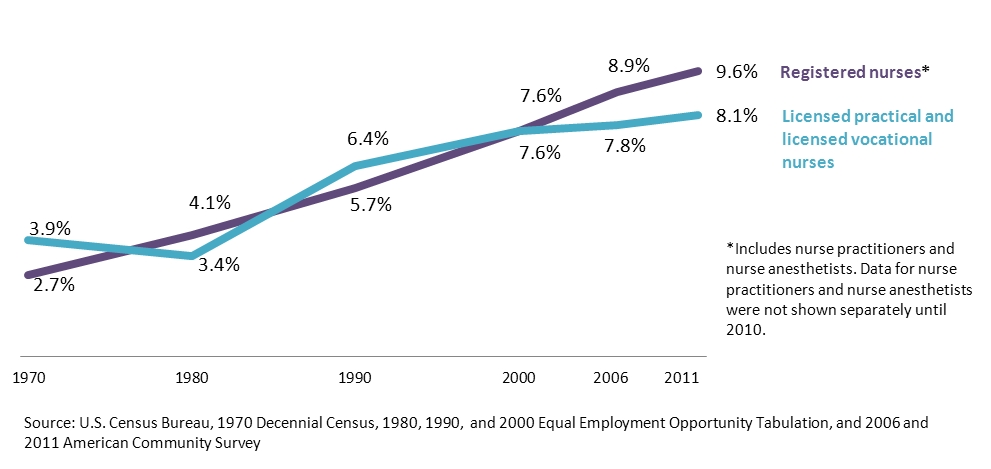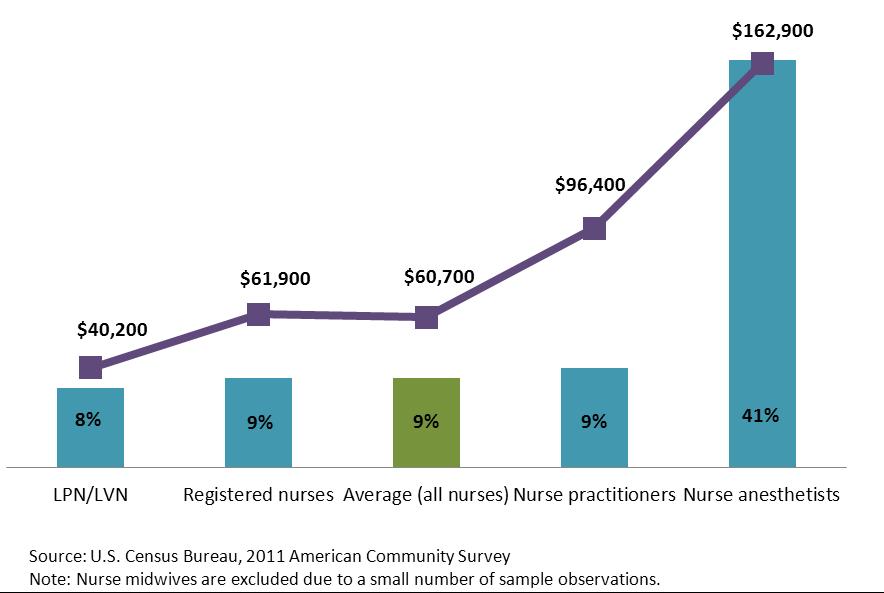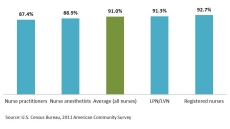Men in Nursing Occupations
Men in Nursing Occupations
In 2011, there were 330,000 men employed as nurses in the United States – about 9 percent of all nurses.
Though now seen as a predominately female occupation, men had significant representation in nursing until the 1800s because of the early association between nursing and the military and religious orders. As the need for nurses expanded during the Civil War along with a shortage of men to provide nursing care, women were allowed to fill the gap. By the early 1900s, many nursing schools only admitted women and the newly-formed Army Nurse Corps and Navy Nurse Corps were limited to women. Men were not allowed to serve as nurses until after the Korean War. As such, men’s representation in nursing experienced significant decline in the 1900s.
However, men’s representation in nursing has been growing since the 1970s.A predicted shortage of nurses has increased recruiting and occupational retraining efforts to increase the pool of employable workers in this field. These efforts have included recruiting men into nursing. Schools are now actively pursuing higher male enrollment in their nursing programs. The relatively high wages and expanding job opportunities makes this field attractive, offering stability even during recessions.
Figure 1 shows the increase in men’s representation among registered nurses and licensed practical and licensed vocational nurses since 1970. About 2.7 percent of registered nurses were men in 1970 compared with 9.6 percent in 2011. Men’s representation among licensed practical and licensed vocational nurses grew from 3.9 percent in 1970 to 8.1 percent in 2011.1
Figure 1. Percentage of Nurses Who Are Men From 1970 to 2011
1The difference between the 2011 estimate and the 2000 and 2006 estimates for percentage of licensed practical and licensed vocational nurses who are men is not statistically significant.
Until recently, the Census Bureau did not collect refined categories of nursing, preventing nuanced analyses of trends in nursing. Starting in 2010, the Census Bureau split the occupational category of registered nurse into four occupations: registered nurse, nurse anesthetist, nurse midwife, and nurse practitioner. We are now able to examine men’s representation in more specific nursing occupations. Because educational requirements, job tasks, and earnings vary significantly by type of nurse occupation, it is important to look at trends in more refined occupational categories.
Men in Nursing Occupations
Men are more likely to be found in highly-paid nursing occupations. Although women make up a disproportionate share of all nursing occupations, men’s representation is highest among nurse anesthetists. About 41 percent of nurse anesthetists are men. Figure 2 shows men’s median earnings in each of the nursing occupations along with their representation in each of the nursing categories. Nurse anesthetists earn more than twice as much as the average for all nursing occupations. Male nurse anesthetists earn, on average, $162,900 per year, while men’s average earnings for all nursing occupations is $60,700 per year.
Figure 2. Male Median Earnings by Percent Male in Nursing Occupations: 2011
Among men and women in the same nursing occupations, men outearn women. Figure 3 shows that women working full-time, year-round earn 93 cents for every dollar men earn as registered nurses, 89 cents to the dollar among nurse anesthetists, 87 cents to the dollar among nurse practitioners, and 91 cents to the dollar among licensed practical and licensed vocational nurses.* While women’s earnings in nursing fields are not on parity with men’s, the wage gap is smaller than the average across all occupations: 77 cents to the dollar.
Figure 3. Female Earnings as a Percentage of Men’s Earnings among Full-Time, Year-Round Nurses: 2011*
This report is based on a new set of tables that present selected characteristics of men and women in nursing occupations. These tables provide estimates on employment status, age, race, Hispanic origin, citizenship, educational attainment, work hours, time of departure to work, median earnings, industry, and class of worker by sex for registered nurses, nurse anesthetists, nurse practitioners, and licensed practical and licensed vocational nurses. The tables are available on the Census Bureau’s Industry and Occupation Statistics Web site at //www.census.gov/hhes/www/ioindex/reports.html.






